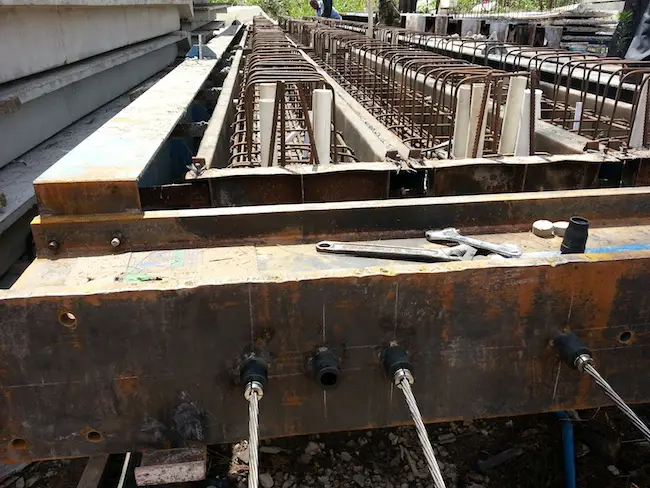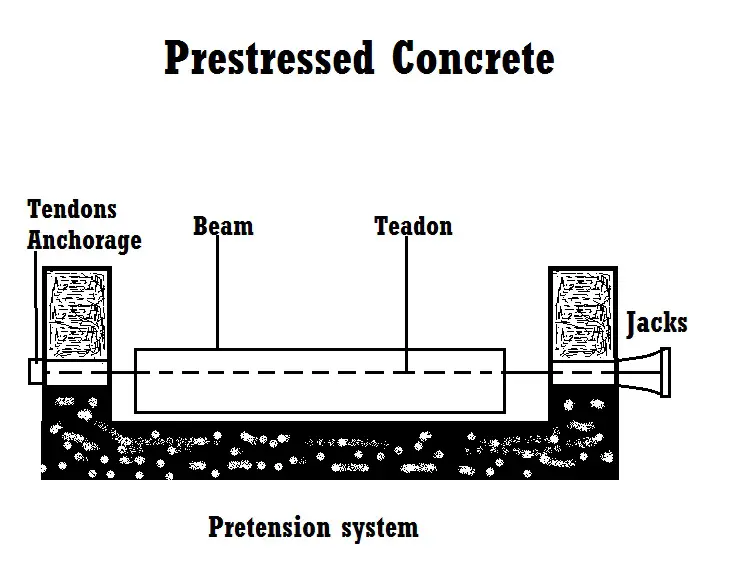Prestressed Concrete | Pre-Tensioned Concrete | Bonded & Post-Tensioned Concrete
Prestressed Concrete | Pre-Tensioned Concrete | Bonded & Post-Tensioned Concrete
Prestressed Concrete
Prestressed concrete is a structural concrete material that allows for the placement of specified engineering stresses in members to counterbalance the stresses that develop when they are loaded.
Prestressed concrete blends concrete’s strong compressive strength with steel’s high tensile strength. It is significantly “prestressed” (compressed) during production, which reinforces it against tensile stresses that would exist in service.
This compression is caused by the tensioning of high-strength “tendons” placed within or close to the concrete, and it is done to increase the concrete’s performance in service.
Tendons are typically formed of high-tensile steels, carbon fiber, or aramid fiber and can be constructed of single wires, multi-wire strands, or threaded bars.
The core of prestressed concrete is that, after the initial compression, the resulting material exhibits the characteristics of high-strength concrete when subjected to future compression forces and of ductile high-strength steel when subjected to tension stresses.
In many cases, this can result in increased structural capacity and/or serviceability over traditionally reinforced concrete.
Internal stresses are introduced in a prestressed concrete part in a planned manner so that the stresses caused by superimposed loads are counteracted to the correct degree.
Prestressed concrete Applications and Uses
Prestressed concrete is utilized in a variety of construction and civil projects, where its superior performance allows for greater spans, decreased structural thicknesses, and material savings over plain reinforced concrete.
High-rise buildings, foundation systems, residential slabs, bridge and dam structures, Tanks and silos, industrial pavements, and nuclear containment structures are examples of typical applications.
Pre-tensioned concrete, which was first employed in the late 1800s, has evolved beyond pre-tensioning to include post-tensioning, which occurs after the concrete is poured.
Tensioning systems are classified as either monostrand, in which each strand or wire of a tendon is stressed individually, or multistrand, in which all strands or wires of a tendon are stressed simultaneously.
Tendons can be situated within the concrete volume (internal prestressing) or entirely outside of it (external prestressing) (external prestressing). Post-tensioned concrete can employ either bonded or unbonded tendons, whereas pre-tensioned concrete employs tendons that are directly bonded to the concrete.
Prestressed concrete is a highly versatile construction material because it is an almost ideal combination of its two main constituents: high-strength steel that has been pre-stretched to allow its full strength to be easily realized; and modern concrete that has been pre-compressed to reduce cracking under tensile forces.
Its broad range of use is mirrored in its inclusion in major design codes covering the majority of structural and civil engineering disciplines, including buildings, bridges, dams, foundations, pavements, piles, stadiums, silos, and tanks.
Types of Pre-stressed Concrete
According to the construction method, there are to kinds of prestressed concrete:
- Pre-tensioned concrete
- Post-tensioned concrete.
- Bonded /Ubounded Post-tensioned concrete
Pre-Tensioned Concrete
What is Pre-Tensioned Concrete?
Pre-tensioned concrete is a technique in which cables are embedded in concrete before it has set, then tightened later to create a compressive stress in the concrete.
Tension in these cables helps to eliminate cracking in the concrete, which can be caused by shrinkage and tension caused by temperature changes. As the concrete dries, it attaches to the tendons, releasing the end-anchoring of the tendons and transferring the tendon tension forces to the concrete as compression through static friction.
Pre-tensioning is a popular prefabrication process in which the resulting concrete element is constructed away from the final structure location and then moved to the site once cured.
It necessitates the use of strong, solid end-anchorage points between which the tendons are stretched. These anchorages serve as the endpoints of a “casting bed,” which can be many times the length of the concrete part being constructed.
This enables several parts to be built end-to-end in a single pre-tensioning operation, resulting in significant productivity gains and economies of scale.
How & Why Is Pre-Tensioning Done?
When a concrete slab is pre-tensioned, the load-carrying capacity is increased substantially. This is achieved by using steel tendons, which are strung through the slab and fixed at its ends. A cable is then pulled, causing the slab to contract.
Concrete slabs are created with a certain load capacity, but this is often not enough for the contents of the building. This is where pre-tensioning becomes important because it provides an additional layer of protection.
Pretensioning occurs before to the casting of the concrete. This is accomplished by inserting high tension steel tendons into the desired profile in which the concrete will be cast. When the concrete has acquired the requisite strength, the tendons are released, causing the concrete to compress.
When designing a concrete slab, the engineers will work out the amount of pre-tensioning required for the design. This will depend on the strength of the tendons and what the weight-bearing capacity of the slab
Here are three benefits of using this technique to build your next building, floor, or sidewalk.
– The finished product is stronger
– It is less prone to shrinkage
– It requires less finishing material
Post-Tensioned Concrete
Post-tensioned concrete is a technique in which cured concrete is placed over wires, which are then tightened to pull the concrete tight to an underlying layer.
Post-tensioned concrete is a prestressed concrete variation in which the tendons are tensioned after the surrounding concrete structure has been cast.
This compression of the concrete causes it to be much stronger than traditional concrete. There are a variety of reasons why post-tensioned concrete is growing in popularity.
These include that it is stronger, lasts longer, and is faster to install. Post-tensioned concrete also works great in high-rise construction, as well as other kinds of structures that are self-supporting, such as bridges.
Post-tensioned concrete is a building material with high compressive strength. It is usually used in the construction of bridges, buildings, and other structures.
The post-tensioning process is an important element of post-tensioned concrete as it allows a concrete deck to remain flat.
Consisting of steel cables and high-strength bolts, post-tensioned concrete is an important element of post-tensioned concrete as it allows a concrete deck to remain flat.
The cables are anchored under the ground and are stretched to apply tension to the concrete slabs. A high compression strength ensures stronger structures and slabs that are less prone to cracking.
Post Tensioned Concrete Slab
Post-tensioned slabs are compressed slabs with high-strength tensioned steel strands, keeping the majority of the concrete in compression.
When compared to reinforced concrete, this results in a more efficient structure that minimizes material usage and reduces the economic span range.
Flat slabs, band beam and slabs, or ribbed slabs are the most common types of post-tensioned slabs.
Post-tensioned slabs are the thinnest slab type since the concrete is pushed to its strengths and is usually kept in compression. Prestress, which can also be employed to counteract deflections, allows for longer spans.
Post tensioning reduces or eliminates shrinkage cracking-therefore no joints, or fewer joints, are needed. Cracks that do form are held tightly together. It allows slabs and other structural members to be thinner. It allows us to build slabs on expansive or soft soils.
Post Tension Slab Details
A post tension slab is a mix of traditional slab reinforcing and projecting high-strength steel tendons that are subjected to tension after the concrete has set. This hybridisation contributes to the creation of a significantly thinner slab with a greater span and no column-free regions.
Is Post Tension Better Than Rebar?
Post-tensioning, a type of prestressing, has various advantages over traditional reinforcing steel (rebars): It decreases or eliminates shrinkage cracking, which means no or fewer joints are required. Cracks that do occur are held together securely. It allows for thinner slabs and other structural elements.
Post Tension Slab Problems
Three factors can cause post-tension slab failure:
- Uneven loads on the foundation are caused by the house’s non-uniform weight distribution. Some foundations will encounter larger loads than others, putting extra strain on the soil underlying the foundation.
- The non-uniform thickness of the earth beneath the foundation causes variations in the support offered to the foundation from below.
- Droughts can be disastrous to a building’s foundation.
Bonded Post-Tensioned Concrete
Bonded post-tensioned concrete is a phrase used to describe a method of applying compression after pouring concrete and throughout the curing process (in situ).
Tendons are permanently connected to the surrounding concrete in bonded post-tensioning by in situ grouting of their encapsulating ducting (after tendon tensioning). This grouting is done for three main reasons:
- To keep the tendons from corroding
- To permanently “lock-in” the tendon pre-tension, removing the need for long-term reliance on end-anchorage systems.
- To improve the final concrete structure’s structural behaviour.
The concrete is cast around curved ducts composed of plastic, steel, or aluminum that are inserted in the area of the concrete element where tension would arise. Before the concrete is poured, tendons are fished through the ducts.
When the concrete hardens, hydraulic jacks that respond against the concrete member tighten the tendons.
When the tendons have stretched sufficiently, they are jammed in place and sustain tension when the jacks are removed, sending pressure to the concrete. To protect the tendons from corrosion, the duct apertures are subsequently grouted.
This technology is widely employed to generate monolithic slabs for house construction in areas where expansive soils make the usual perimeter foundation ineffective.
All loads from the underlying soil’s yearly expansion and contraction are absorbed by the entire tensioned slab, which supports the building without significant flexure.



